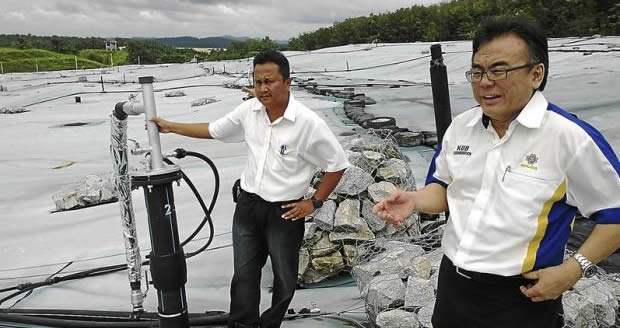
The future of waste disposal
YESTERDAY, StarMetro explored the current solid waste management situation in the Klang Valley and today, we take a look at the future of the industry.
KUB-Berjaya Enviro Bhd managing director Chock Eng Tah believes that the answer is already at hand — the sanitary landfill in Bukit Tagar, which was built by the Federal Government.
Chock, whose company manages the site, said at current rates of disposal, the landfill should be good for another 70 years.
“We receive about 2,500 to 3,000 metric tonnes of trash every day, mainly from the Taman Beringin transfer station. This translates to almost a million metric tonnes a year.
“We have 13 planned cells at the site, each with a capacity of about 120mil metric tonnes.
“Taking into account population growth, this place should last 70 years or even longer,” Chock said.
A sanitary landfill is different from what we are used to — mountains of rubbish — in that it is the result of careful engineering to ensure the leachate, liquid that has gone through the waste and contains all kinds of toxins, is carefully drained and treated.
They also divide the area into cells that are lined with various layers to ensure the leachate is contained and does not mix with rainwater or groundwater.
The sanitary landfill in Bukit Tagar also has a containment bund around the the computerised leachate treatment plant and a 500m buffer zone around the site.
These safeguards have already won the landfill several international awards for its environmental efforts, including the recent Singapore Environment Council’s CDL Outstanding Singapore Environmental Achievement Award.
According to Chock, the company used the methane produced at the site to generate 4MW of electricity that was sold to TNB and fed into the national grid.
“We can produce up to 10MW.
“Currently, we are experimenting with solar energy and setting up flexible membranes on the advance cell that was closed and covered after it reached full capacity a few years ago,” he said, adding that the site was also equipped with regular solar panels.
Leachate at the landfill is carefully drained and channelled to the computerised leachate treatment plant that runs on a 24-hour cycle. This produces treated leachate that is further purified by reed beds, leaving behind clear water that is dispersed through an extensive sprinkler system on-site.
One of the more surprising effects of this carefully planned and executed project is that there is barely any smell, except at the leachate treatment plant, where the liquid is placed in open containment ponds or is aerated in the lagoons during treatment.
They have also successfully created a system where rainwater does not mix with the leachate and runs into stormwater ponds where fish and plants thrive.
Chock said the cells could even be reused, with a new layer of rubbish piled on top as the rubbish settles. This is possible because the leachate drainage and methane gas collection pipes are already in place, creating a more cost-efficient system as time passes.
There are two other sanitary landfills in Selangor — Tanjung Dua Belas in Kuala Langat and Jeram in Kuala Selangor — both operated by Worldwide Holdings Bhd.
Currently, the sanitary landfills have a tipping fee of between RM28.80 and RM36 per tonne, one of the cheapest in the world compared to Germany, which charges between RM1,000 and RM1,400; Australia, RM215; and China, RM60 to RM75.
“The waste we receive now is mainly from Kuala Lumpur as well as the Selayang Municipal Council. We estimate the total amount of trash generated by the entire Klang Valley to be about 6,000 metric tonnes per day and it is no problem for us to accept it all tomorrow.
“It is just a matter of hiring more people to run the cells and bringing forward the opening of a new one in a couple of years or so,” Chock said




